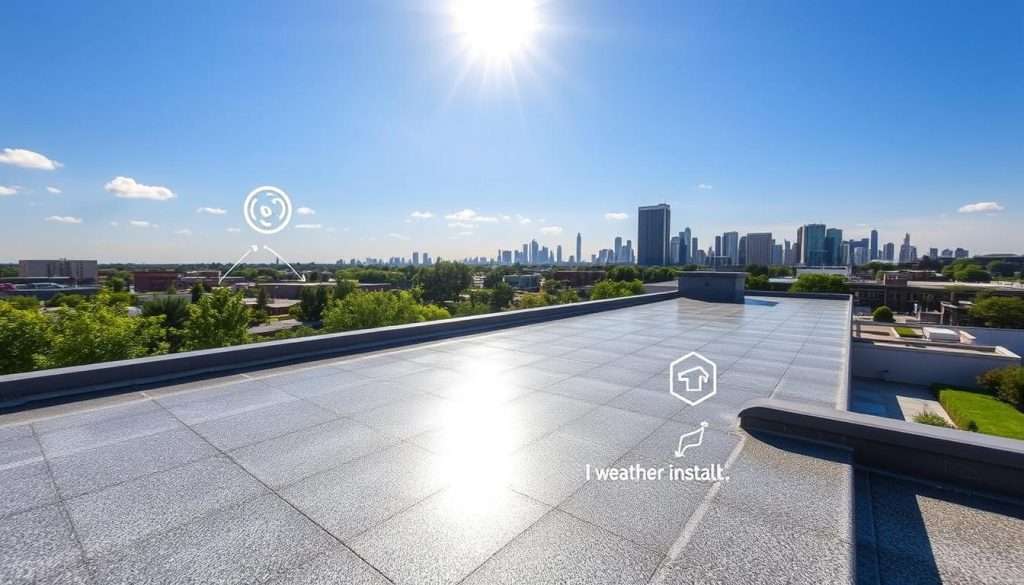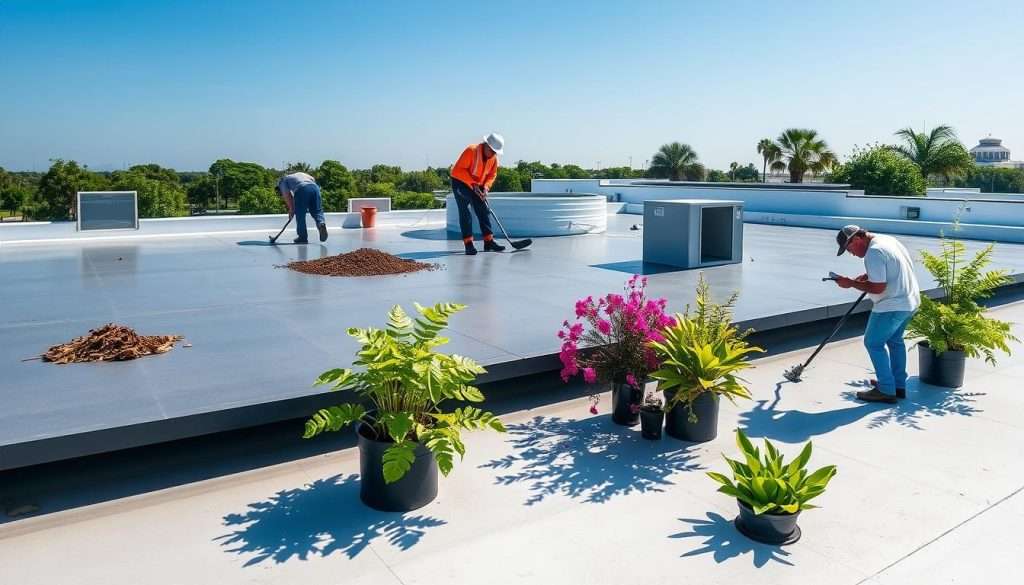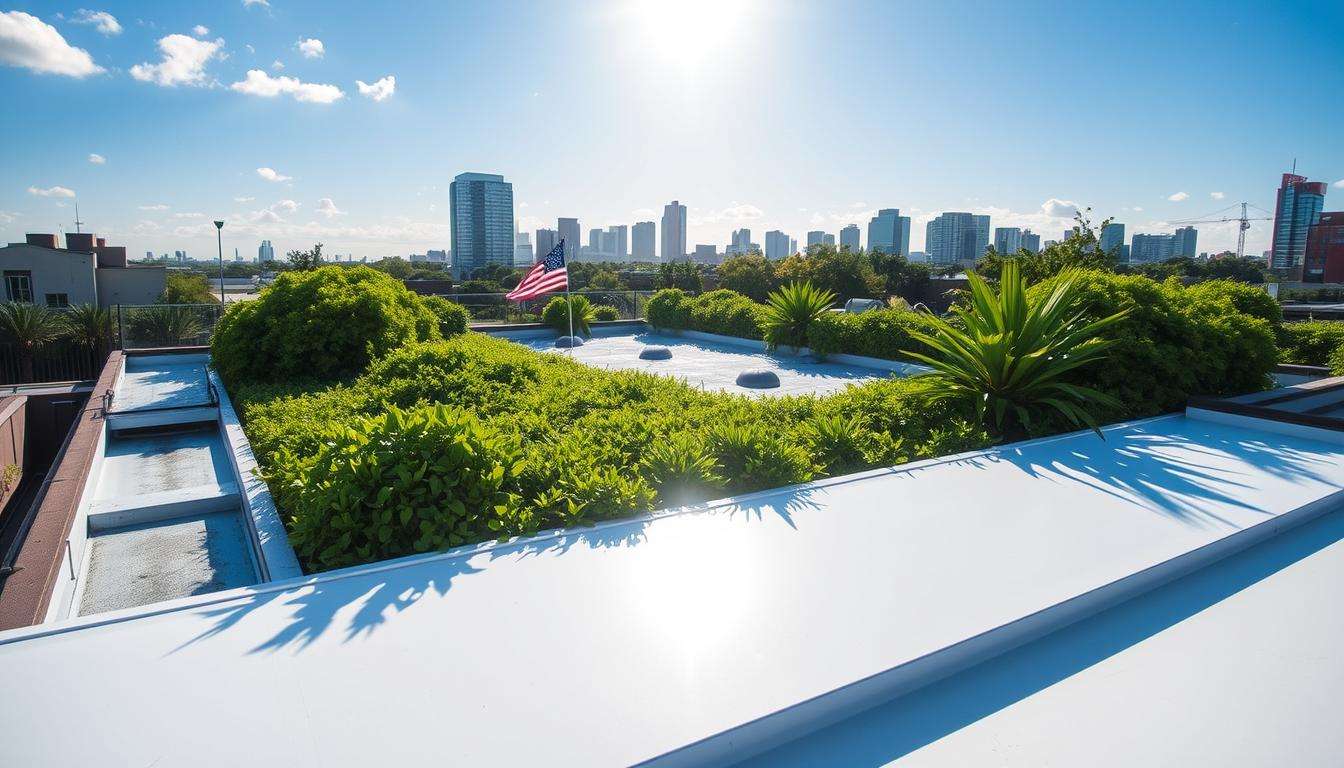If you own a home or a business, you might wonder, what is a TPO roof? TPO, or Thermoplastic Polyolefin, is a top pick for buildings. It’s strong and saves energy. The National Roofing Contractors Association (NRCA) says TPO roofs are in 40% of commercial buildings.
These roofs have special properties that cut down cooling costs. They are great for many kinds of buildings.
A TPO roof has three parts: a base, a middle layer, and a top layer. The top layer is very weather-resistant. TPO roofs can last 15 to 30 years, depending on how well they are installed and cared for.
Knowing the tpo roofing benefits helps you make a smart choice for your property.
In our detailed guide, we’ll explore TPO roof advantages, how to install them, and upkeep tips. For more info, see this guide.
Understanding TPO Roofing
TPO roofing is a top pick for commercial buildings. We’ll look at what makes a TPO roof, its history, and where it’s used.
Definition of TPO Roofing
TPO stands for thermoplastic olefin. It’s a single-ply roof made from polypropylene and ethylene-propylene rubber. It’s flexible and strong, lasting 15 to 20 years.
History and Development of TPO
TPO roofs started in the late 20th century. They quickly became popular, now making up nearly 40% of the market. They’re known for being cost-effective and saving energy.
Common Uses of TPO Roofs
TPO roofs are great for commercial and industrial buildings. They’re affordable and versatile. Here are some places they’re used:
- Flat or low-slope roofs in commercial buildings
- Industrial warehouses and manufacturing facilities
- Retail stores and shopping centers
- Institutional structures, such as schools and hospitals
TPO roofs are in high demand. They’re seen as a better choice than older materials.
| Attribute | TPO Roofing |
|---|---|
| Market Share | Approximately 40% |
| Typical Lifespan | 15-20 years |
| Price Comparison | 25-35% cheaper than PVC |
| Thickness Options | 45, 60, 80, and 90 mils |
| Environment Impact | 100% recyclable |
| Reflectivity | Heat-reflective and energy-efficient |
Benefits of TPO Roofing
Choosing a roofing material is important. TPO roofing is great because it saves energy and is good for the planet. It’s also affordable and lasts a long time.
Energy Efficiency and Sustainability
TPO roofing is very good at saving energy. Its bright white color reflects sunlight, which lowers heat. This means you use less air conditioning, saving money.
It’s also good for the environment. TPO roofs are made without chlorine and can be recycled. This makes them a green choice.
Cost-Effectiveness
TPO roofs are affordable. They cost less than many other materials. This is because they are light and easy to install.
They also don’t need much upkeep. This saves money over time. TPO roofs are a smart choice for saving money.
Durability and Longevity
TPO roofs are very strong. Their seams are welded, making them leak-proof. They can handle bad weather better than some other materials.
With care, TPO roofs can last 30 years or more. This makes them a reliable choice for many buildings.

TPO Roof Installation Process
Knowing how to install a TPO roof is key for a good job. It makes your roof last longer and work better. First, you prepare, then apply the roof, and finally check it after.
Preparation and Materials
Getting ready is the first step. This means:
- Checking the roof you have now
- Picking good materials, like TPO membrane thickness, which is 45 mil to 90 mil
- Adding insulation to save energy
Working with top TPO roofing contractors means you get the right stuff for your building.
Application Techniques
Putting on the TPO roof needs care. Important steps are:
- Rolling out the TPO and fastening it with screws or glue
- Using a hot-air gun to seal the seams tight
- Fixing the edges and flashing around vents and chimneys to stop leaks
Post-Installation Inspections
After putting it on, checking it well is very important. Look for:
- Good sticking and sealed seams
- Working drainage to keep water away
- Roof’s strength to last long
These steps keep your roof in top shape. Regular checks help it last longer, making your money worth it.
| Step | Description | Importance |
|---|---|---|
| Preparation | Evaluate existing roof, select appropriate materials, and insulate if necessary. | Sets the foundation for successful installation. |
| Application | Install TPO membrane with fasteners or adhesives, weld seams with hot-air guns. | Ensures a watertight and durable roof. |
| Inspections | Thorough checks for adhesion, drainage, and integrity post-installation. | Guarantees long-term performance and efficiency. |
Maintenance of TPO Roofs
It’s important to keep your TPO roof in good shape. This can help it last up to 25 years. Regular checks and care are key to avoid expensive fixes later.
Regular Maintenance Practices
Doing routine checks helps find problems early. This keeps your roof in great shape. Here are some tips:
- Look for wear and tear, like holes or lifted seams.
- Keep the roof clean to stop mold and water buildup.
- Use a gentle pressure washer to clean the roof.
- Check the drainage to make sure water flows away.
Identifying Common Issues
Knowing common problems helps you fix them fast. Watch for:
- Moisture where sealants might be failing.
- Water pooling after rain, which is bad for flat roofs.
- Mold, algae, or dirt, which means it’s time to clean.
When to Seek Professional Help
While you can do a lot yourself, some jobs need a pro:
- Big damage should be checked by a TPO expert.
- When maintenance is too much, get a pro to do it right.
- After bad weather, a pro can check for damage.

TPO Roofing vs. Other Systems
Knowing the differences between roofing systems is key. This helps you choose the best for your building. TPO, PVC, and EPDM are compared based on performance, how long they last, and what climate they work best in.
Comparison with PVC Roofing
TPO is a good choice over PVC because it’s cheaper and better for the planet. Both are easy to put on and save a lot of energy. But, PVC has been around longer, since the 1960s. Here’s a comparison:
| Feature | TPO Roofing | PVC Roofing |
|---|---|---|
| Established Use | Since the 1990s | Since the 1960s |
| Energy Efficiency | Yes, highly reflective | Yes, highly reflective |
| Cost | Generally lower | Generally higher |
| Durability | Life expectancy of 22-30 years | Generally longer-lasting |
TPO vs. EPDM Roofing
Both TPO and EPDM have their good points. EPDM lasts about 25-30 years, while TPO is cheaper but lasts a bit less. TPO also reflects sunlight well, which can save a lot on cooling costs. Here’s a look at both:
| Aspect | TPO Roofing | EPDM Roofing |
|---|---|---|
| Average Service Life | 15-30 years | 25-30 years |
| Sunlight Reflection | Excellent | Poor |
| Puncture Resistance | Better | Generally good |
| Cost | Higher upfront | Lower upfront |
Suitability for Different Climates
TPO is great for places with lots of sun because it reflects it well. This can really cut down on energy costs. Learn more about TPO and EPDM in different climates. For more info, check out this article on TPO roofing specifications.
Choosing the Right TPO Roofing Contractor
Finding the best TPO roofing contractors is key for a long-lasting roof. Look for contractors with TPO training and licenses. They should also have a good track record of successful installations.
What to Look for in a Contractor
Check their credentials and ask important questions. Get written estimates from different contractors. This helps you compare prices and services.
Ask about their experience with TPO roofs. Find out about their warranty options. For example, JW Roofing offers a 10-year warranty.
Questions to Ask Potential Contractors
Ask about their past projects and client references. A contractor with lots of TPO experience can offer valuable insights. Also, make sure they offer maintenance plans to protect your roof.
Evaluating Contractor Credentials and Experience
Choosing the right contractor is crucial. Companies like JW Roofing in Ohio have a lot of experience. A qualified contractor ensures your roof is installed correctly, giving you peace of mind.
